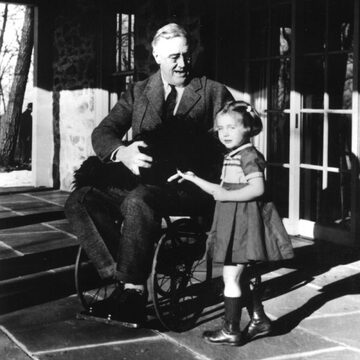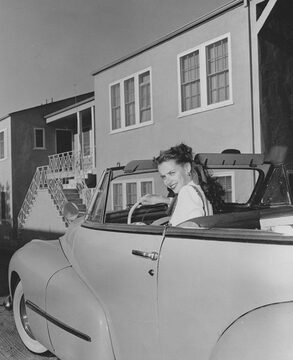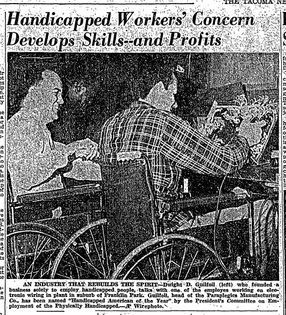(This is a continuing series about Native American artist Eugene Landry.)
In an effort to understand Eugene’s life I’ve been trying to understand what it was like to be disabled (back then the term was crippled or handicapped) in mid-century America. Many of the people I’ve interviewed who knew Gene did not know why he was in a wheelchair. It’s a subject, in general, that makes people uncomfortable. Back in those Post War days, there was a lot people didn’t talk about. At the same time, however, the seeds of revolution were being sown, and I looked to news stories and popular culture of the time for clues.
The fact that Americans elected a president in a wheelchair seems miraculous, even today. But in 1932, FDR had the cooperation of the press to downplay his disability. He was photographed standing at podiums not being pushed in a chair. He drove a car with hand controls. Using the invisible medium of radio he engendered confidence with his words and voice.

Susan Peters
Actors with disabilities were rarely seen on the screen, especially in the 1940s-50s. While Lionel Barrymore had a successful career as a character actor, actress Susan Peters was not so lucky. While on a hunting trip in 1945 Peters was accidentally shot by her husband, film director Richard Quine. She was a rising MGM star until the injury that left her paralyzed from the waist down. Determined to continue her career, after hospitalization Peters returned to the studio but found few roles. She played a wheelchair-bound villain in The Sign of the Ram, then went to the stage. By 1952, suffering from clinical depression over the dissolution of her marriage and her limited career options, Peters ended her life, age 31.

Dwight Guilfoil
As I scrolled through newspaper archives for information about meningitis, the disease that paralyzed Gene, I found a story about World War Two pilot Dwight Guilfoil. He contracted meningitis and polio during the war. As a civilian, he couldn’t find a job. In 1950 he founded a manufacturing company that eventually employed over 100 physically handicapped workers. In 1960 he was awarded the Handicapped American of the year award by president Eisenhower. Guilfoil said, “ Industry’s reluctance to employ the physically impaired is simply another form of discrimination, resulting in mental segregation as rigid as that established by the most severe Jim Crow law.”

Television’s First Disabled Hero; Ironside

Seven years after Guilfoil’s Presidential award, a crime drama premiered on television featuring a disabled detective. Set in San Francisco, Ironside confronted the issues of the day-civil rights, counter culture, the generation gap. Today it is both a marker of social progress and of how far we still have to go. Ironside’s handpicked team included an African American youth, Mark Sanger (Don Mitchell) and a female policewoman (Barbara Anderson).
In the pilot episode, Chief Ironside is shot by a sniper. He survives but is paralyzed. Discharged from the hospital in a wheelchair he meets with the police commissioner in their favorite bar. Ironside asks to return to work.
The commissioner tells him “It’s not up to me. I’d be glad to have you in the department anytime-in or out of a wheelchair-but there are rules.”
At that time there were no laws prohibiting discrimination against individuals with disabilities. Twenty-two years later, in 1990, The Americans with Disabilities Act (ADA) became law. The ADA is a civil rights law that prohibits discrimination against individuals with disabilities in all areas of public life, including jobs, schools, transportation, and all public and private places that are open to the general public.
The only way Ironside can continue to work for the city is as a “qualified volunteer”. He offers to work for free. Ironside gets an office, a staff, equipment and a great theme song by Quincy Jones. The show continued for eight seasons. The show was awarded an image award by the NAACP in 1968 for “developing Mark as an intelligent and angry young black man.” (Cy Chermack, producer)
In 2013, Ironside was remade for television starring Blair Underwood as chief Ironside. Both Burr and Underwood could walk away from their wheelchairs, unlike the character they portrayed.
Disabled advocacy groups are angry about the casting of non-disabled actors in parts written for disabled characters. Some liken this to the outmoded practice of casting Caucasian actors in ethnic roles. A Washington Post Headline reads “Disabled actors say they are the last civil rights movement in Hollywood.” The story goes on to say; “The disabled are, arguably, the largest minority in America, its 56.7 million members constituting nearly 20 percent of the population, according to the 2010 Census. But a study from the University of Southern California Annenberg Inclusion Initiative that combed through 900 popular movies from 2007 to 2016 found that only 2.7 percent of characters with speaking roles were portrayed as disabled.”
As I finish writing this post, Variety has announced that CBS Entertainment made a commitment to “audition actors with disabilities for new productions picked up to series”. This is in response to advocacy organization’s request for increased disabled representation.
History is being made today.
As the ad said in 1968;
“You’ve Come a Long Way, Baby.”
